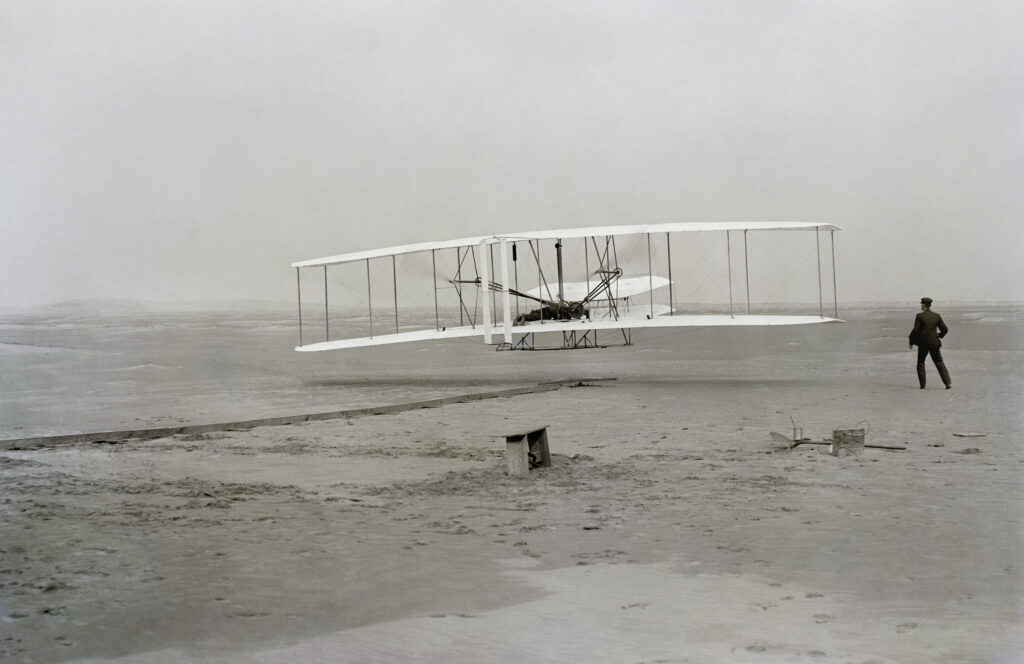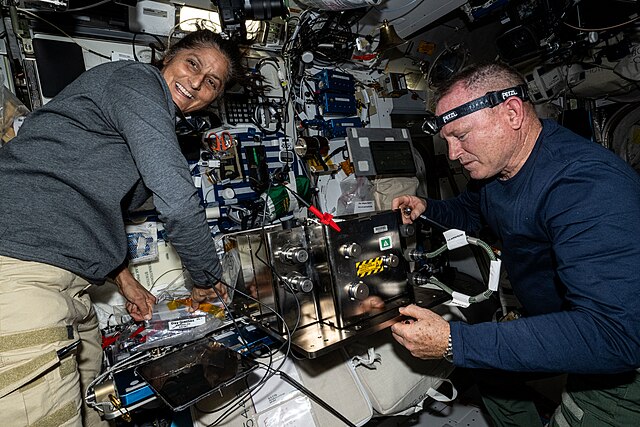by Alex Dersch
The history of aeronautics is filled with remarkable aircraft that have made significant contributions to military strategy, technological advancements, and the culture of flight. From the roaring skies of World War II to the precision aerobatics of the modern-day, each aircraft has a unique story and a lasting impact on aviation.
From August 31 to September 2, join Evergreen at the Air Show Watch Party to view an impressive lineup of iconic aircraft, and witness their storied legacies firsthand. Let’s explore the significance of some of this year’s notable aircraft!
USAF Thunderbirds
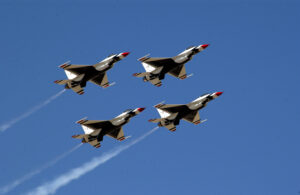
The United States Air Force (USAF) Thunderbirds are more than just an aerobatic team; they are a symbol of precision, professionalism, and the prowess of the USAF. Flying the F-16 Fighting Falcon, the Thunderbirds perform intricate maneuvers and high-speed formations that demonstrate the capabilities of modern fighter jets.
Technologically, the F-16 introduced fly-by-wire control systems, which allow for greater precision and agility in flight. The Thunderbirds’ performances inspire awe and pride, showcasing the skills of the pilots and the technological advancements in military aviation. The Thunderbirds also play a crucial role in recruitment and public relations, connecting the Air Force with communities across the nation.
US Navy Growler
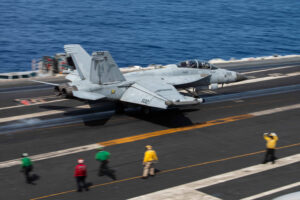
The Boeing EA-18G Growler is a specialized electronic warfare aircraft used by the US Navy. Its primary mission is to jam enemy radar and communications, providing essential support for strike missions and enhancing the survivability of friendly forces. The Growler is a variant of the F/A-18F Super Hornet, equipped with advanced jamming equipment and sensors.
It features the ALQ-218 receiver system and the ALQ-99 jamming pods, which are pivotal in electronic attack and suppression of enemy air defenses. The Growler’s importance lies in its ability to suppress enemy air defenses, allowing for successful operations in contested environments. The Growler’s capabilities ensure that the US Navy maintains a technological edge in modern warfare.
P-47 Thunderbolt – Erikson
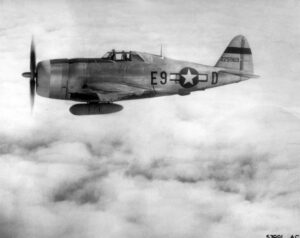
The Republic P-47 Thunderbolt, affectionately known as the “Jug,” was one of the most formidable fighters of World War II. The Erikson Aircraft Collection’s P-47 is a beautifully restored example of this legendary aircraft. Known for its ruggedness, heavy armament, and powerful radial engine, the P-47 excelled in both air-to-air combat and ground attack missions.
Its durability and firepower made it a favorite among pilots, and it played a critical role in achieving air superiority and providing close air support for ground troops during the second world war.
Focke-Wulf 190
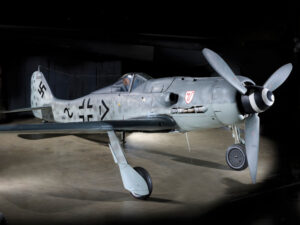
The Focke-Wulf Fw 190 was one of Germany’s most advanced and effective fighters during World War II. Designed by Kurt Tank, the Fw 190 boasted a powerful BMW radial engine, excellent handling characteristics, and heavy armament. It featured advanced technology for its time, including a robust airframe and effective armament configuration with cannons and machine guns.
The Fw 190 earned a reputation for being a formidable opponent in dogfights and was respected by Allied pilots. Its impact on aerial combat and its role in defending the Third Reich‘s skies make it a significant aircraft in aviation history.
Messerschmitt ME-109
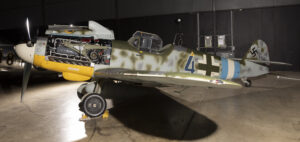
Another iconic German fighter, the Messerschmitt Bf 109, known colloquially as the ME-109, was the backbone of the Luftwaffe’s fighter force. It saw extensive service throughout World War II and was involved in every major theater of the conflict.
The ME-109 was renowned for its agility, speed, and advanced features, such as an all-metal monocoque construction, a closed canopy, and leading-edge slats for improved maneuverability. Pilots like Erich Hartmann, the highest-scoring ace in history, flew the Bf 109 to great effect. Its design and performance influenced future generations of fighter aircraft.
P-51 Mustang “Plum Crazy”
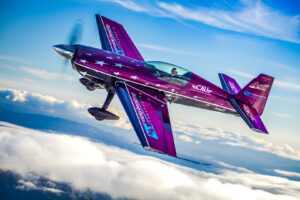 The North American P-51 Mustang is often hailed as the finest piston-engine fighter of World War II. “Plum Crazy” is a particular P-51 that embodies the aircraft’s legacy of excellence. With its sleek design, powerful Rolls-Royce Merlin engine, and long-range capabilities, the Mustang excelled in escort missions, protecting bombers deep into enemy territory.
The North American P-51 Mustang is often hailed as the finest piston-engine fighter of World War II. “Plum Crazy” is a particular P-51 that embodies the aircraft’s legacy of excellence. With its sleek design, powerful Rolls-Royce Merlin engine, and long-range capabilities, the Mustang excelled in escort missions, protecting bombers deep into enemy territory.
Technologically, it introduced laminar-flow wings, which reduced drag and improved performance. The Mustang’s contributions to the Allied victory in Europe and its enduring popularity among warbird enthusiasts highlight its aviation importance.
Yellow Thunder – 2 Harvards
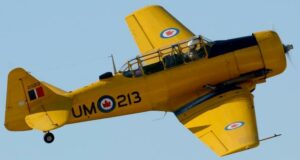 The North American Harvard, also known as the T-6 Texan, was a primary trainer aircraft used by Allied forces during World War II. The “Yellow Thunder” duo of Harvards pays homage to the thousands of pilots who trained in these aircraft. The Harvard was renowned for its robustness and forgiving flight characteristics, making it an ideal platform for teaching the fundamentals of flight.
The North American Harvard, also known as the T-6 Texan, was a primary trainer aircraft used by Allied forces during World War II. The “Yellow Thunder” duo of Harvards pays homage to the thousands of pilots who trained in these aircraft. The Harvard was renowned for its robustness and forgiving flight characteristics, making it an ideal platform for teaching the fundamentals of flight.
Its Pratt & Whitney R-1340 radial engine and advanced design for the time played a crucial role in pilot training, laying the foundation for the proficiency and effectiveness of Allied air forces.
Sukhoi West – Two Sukhoi SU-26s
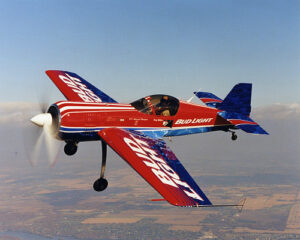
The Sukhoi SU-26 is a Russian aerobatic aircraft designed for competition and performance flying. The Sukhoi West team, flying two SU-26s, showcases the aircraft’s exceptional agility, power, and precision. With a lightweight frame and a powerful engine, the SU-26 can perform breathtaking maneuvers, from tight loops and rolls to complex aerobatic sequences.
The SU-26 features a lightweight composite structure and advanced avionics that enable its high-performance capabilities. The aircraft’s importance lies in its contribution to advancing aerobatic techniques and inspiring new generations of pilots to push the boundaries of what is possible in the sky.
—
Each of these aircraft holds a unique place in aviation history, representing advancements in technology, military strategy, and the art of flying. From the awe-inspiring displays of the USAF Thunderbirds to the technological edge provided by the US Navy Growler, and from the rugged P-47 Thunderbolt to the agile Sukhoi SU-26, these aircraft continue to inspire and educate, reminding us of the rich legacy and ongoing evolution of aviation.
The Evergreen Aviation & Space Museum’s Air Show Watch Party offers a rare opportunity to witness these legendary aircraft in action, celebrating their enduring impact on the world of flight. Don’t miss this chance to experience aviation history come alive from August 31 to September 2. Learn more here or purchase your tickets today!

